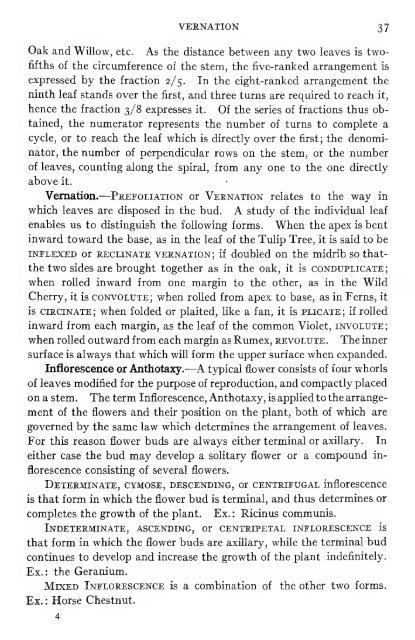Pharmaceutical botany - Lighthouse Survival Blog
Pharmaceutical botany - Lighthouse Survival Blog
Pharmaceutical botany - Lighthouse Survival Blog
You also want an ePaper? Increase the reach of your titles
YUMPU automatically turns print PDFs into web optimized ePapers that Google loves.
VERNATION 37<br />
Oak and Willow, etc. As the distance between any two leaves is two-<br />
fifths of the circumference of the stem, the five-ranked arrangement is<br />
expressed by the fraction 2/5. In the eight-ranked arrangement the<br />
ninth leaf stands over the first, and three turns are required to reach it,<br />
hence the fraction 3/8 expresses it. Of the series of fractions thus ob-<br />
tained, the numerator represents the number of turns to complete a<br />
cycle, or to reach the leaf which is directly over the first; the denominator,<br />
the number of perpendicular rows on the stem, or the number<br />
of leaves, counting along the spiral, from any one to the one directly<br />
above it.<br />
Vernation.— Prefoliation or Vernation relates to the way in<br />
which leaves are disposed in the bud. A study of the individual leaf<br />
enables us to distinguish the following forms. When the apex is bent<br />
inward toward the base, as in the leaf of the Tulip Tree, it is said to be<br />
INPLEXED or RECLiNATE VERNATION; if doubled On the midrib so that-<br />
the two sides are brought together as in the oak, it is conduplicate ;<br />
when rolled inward from one margin to the other, as in the Wild<br />
Cherry, it is convolute; when rolled from apex to base, as in Ferns, it<br />
is circinate; when folded or plaited, like a fan, it is plicate; if rolled<br />
inward from each margin, as the leaf of the common Violet, involute ;<br />
when rolled outward from each margin as Rumex, revolute. The inner<br />
surface is always that which will form the upper surface when expanded.<br />
Inflorescence or Anthotaxy.—A typical flower consists of four whorls<br />
of leaves modified for the purpose of reproduction, and compactly placed<br />
on a stem. The term Inflorescence, Anthotaxy, is applied to the arrangement<br />
of the flowers and their position on the plant, both of which are<br />
governed by the same law which determines the arrangement of leaves.<br />
For this reason flower buds are always either terminal or axillary. In<br />
either case the bud may develop a solitary flower or a compound in-<br />
florescence consisting of several flowers.<br />
Determinate, cymose, descending, or centrifugal inflorescence<br />
is that form in which the flower bud is terminal, and thus determines or<br />
completes the growth of the plant. Ex. : Ricinus communis.<br />
Indeterminate, ascending, or centripetal inflorescence is<br />
that form in which the flower buds are axillary, while the terminal bud<br />
continues to develop and increase the growth of the plant indefinitely.<br />
Ex. : the Geranium.<br />
Ex. :<br />
Mixed Inflorescence is a combination of the other two forms.<br />
Horse Chestnut.<br />
4
















